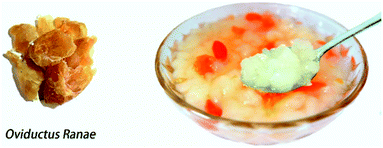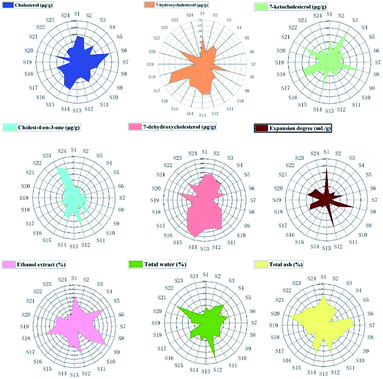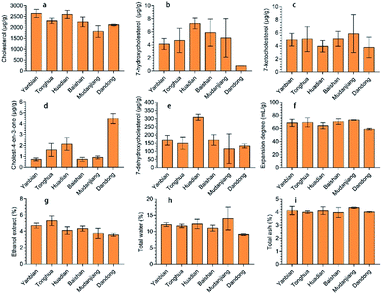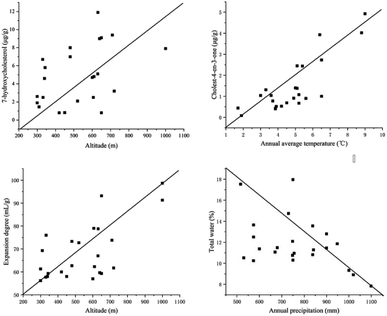 Open Access Article
Open Access ArticleEnvironmental influences on quality features of Oviductus Ranae in the Changbai Mountains†
Yao Xiaoa,
Shuling Nia,
Shihan Wangb,
Yuanshuai Gan a,
Yan Zhoua,
Hongye Guoa,
Min Liua,
Zhihan Wangc and
Yongsheng Wang
a,
Yan Zhoua,
Hongye Guoa,
Min Liua,
Zhihan Wangc and
Yongsheng Wang *a
*a
aSchool of pharmaceutical Sciences, Jilin University, Changchun, Jilin, China. E-mail: mikewangwys@outlook.com; wys@jlu.edu.cn
bCollege of Chinese Herbal Medicine, Jilin Agricultural University, Changchun, Jilin 130118, China
cDepartment of Physical Sciences, Eastern New Mexico University, Portales, NM 88130, USA
First published on 5th November 2019
Abstract
This work studied the influences of environmental factors on the quality features of Oviductus Ranae. Oviductus Ranae is mainly produced in the Changbai Mountains. The samples of Oviductus Ranae were collected from 24 different locations, which covered the main producing areas. The environmental parameters were assessed using a digital raingauge, GPS, a thermometer, and an atmospheric pressure-altimeter. The quality features including expansion degree, ethanol extract, total water, total ash, and five steroid components, of the collected Oviductus Ranae samples were quantified using high-performance liquid chromatography. The results showed that the cholesterol content in the samples collected from the Yanbian Korean region was slightly higher than the others. Samples collected from the Huadian area exhibited much higher contents of 7-hydroxycholesterol and 7-dehydrocholesterol than the rest of the producing areas. The highest content of cholest-4-en-3-one came from the samples collected from Dandong. The contents of 7-keto-cholesterol in samples from different regions were very close. The highest ethanol extract was from the samples in Tonghua. The correlations between the quality features and environmental factors were analyzed by SPSS (version 25.0, SPSS Inc., Chicago, IL, USA). The results showed that the content of cholest-4-en-3-one was related to the annual average temperature. The total water was correlated with the annual precipitation. 7-Hydroxycholesterol and expansion degree were related to the altitude. The results indicated that environmental factors have certain influences on the quality features.
1. Introduction
The dried oviduct of mature female Rana temporaria chensinensis David is termed as Oviductus Ranae which is usually used as a raw material for nutraceuticals (Fig. 1).1,2 Rana temporaria chensinensis David is widely distributed in the Changbai Mountains and is a delicious dish. Oviductus Ranae is one of the most valuable parts of Rana temporaria chensinensis David, known for its high nutritional value properties, such as tonifying kidney essence, nourishing yin and moistening the lungs, improving immunity, and being anti-fatigue.3,4 Currently, there are multiple food forms of Oviductus Ranae such as beverages, canned foods, and soup (Fig. 1). Oviductus Ranae was initially recorded in Bencao Tujing and the Compendium of Materia Medica (Bencao Gangmu or Pen-tsao Kang-mu), and was a royal tribute in the Ming and Qing Dynasties.1,5 Recent studies have shown that Oviductus Ranae has antitussive, and expectorant activities, and inhibits cancer cell proliferation.6,7 Because of these features, Oviductus Ranae is endowed with the reputation of being referred to as “soft gold”.8,9According to reports, the quality evaluation of Oviductus Ranae is based on the degree of expansion, ethanol extract, total ash, total water, analysis of steroid components, etc.10,11 As an important nutrient, steroids played an important role in the quality of Oviductus Ranae.12–14 Among them, cholesterol, as a component of cell membrane, is of great significance in maintaining human metabolism.15,16 7-Hydroxycholesterol has a therapeutic effect on traumatic epilepsy and inhibition of reactive astrocyte proliferation.17 Meanwhile, 7-hydroxycholesterol double half succinate has anti-proliferation and anti-teratogenesis activities.18 7-keto-Cholesterol is one of the main oxidation products of cholesterol in vivo. It has the function of inhibiting the growth of tumor cells and can also regulate the signal transduction of lens cells.19,20 Cholest-4-en-3-one, as the cholesterol oxidation product, was reported anti-obesity, the treatment of liver disease, and preventing skin keratinizing.21–23 7-Dehydrolactam is used to synthesize vitamin D3 intermediate.24 The chemical structures of the five major steroidal components were shown in Fig. 2.
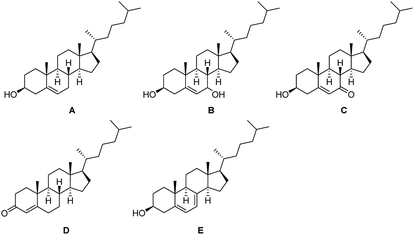 | ||
| Fig. 2 Chemical structures of steroidal components of Oviductus Ranae: A cholesterol, B 7-hydroxycholesterol, C 7-keto-cholesterol, D cholest-4-en-3-one, and E 7-dehydrocholesterol. | ||
The quality features of food are closely related to environmental factors, and chemometrics can be used to identify the food qualities.25–28 The qualities features of Oviductus Ranae from different producing regions in Changbai Mountains are varied due to the influences of environmental factors such as altitude, humidity, sunshine duration, and ambient temperatures. So far, research on Oviductus Ranae has mainly focused on component studies,8,13 authenticity identification,29,30 and pharmacological toxicology evaluation.9,31 The nutrient contents in Oviductus Ranae may vary because of the origins and climates.32,33 Herein we investigated the influence of multiple environmental factors on quality features of Oviductus Ranae in Changbai Mountains. Multivariate linear analysis and grey correlation analysis showed the relationships between the quality features and environmental factors.
2. Experimental
2.1. Materials
24 batches of Oviductus Ranae were collected from Changbai Mountains, which was authenticated by Professor Dacheng Jiang from Changchun University of Traditional Chinese Medicine. The collection sites and environments of Oviductus Ranae were shown in Table 1. Oviductus Ranae was crushed to powder in an HX-200 High Speed Chinese Medicine Crusher (Zhejiang Yongkang Xi'an Hardware Medicine Factory). The weight was measured using CPA-225D Electronic Analysis Balance (Sartorius Scientific Instrument (Beijing) Co., Ltd.). Swelling capacity was measured using a Swelling Measurement Tube (Sichuan Water Instrument Co., Ltd.). The Anglient 1260 High Performance Liquid Chromatography (HPLC) was equipped with a DAD detector (G1315B), automatic sampling device (G1329B) and a column temperature controller. The geographic parameters were collected using LB-1300 Rainfall Measuring Instrument (Qingdao Lubo Jianye Environmental Protection Technology Co., Ltd.), G120BD Beidou Handheld GPS Locator (Beijing Yile Zhichuang Technology Co., Ltd.), Aiwosi W8 digital thermometer (Shenzhen Aiwosi Technology Co., Ltd.). The environmental factors were shown in Fig. 3 and Table 1. Standard compounds A, B, C, D, and E were purchased from EFA Biotechnology Limited company, Chengdu province, purity > 98%. Methanol was chromatographic grade, and other reagents (Beijing chemical industry factory) were analytical grade.| No. | Habitats | Batch number | Altitude (m) | Annual average temperature (°C) | Annual average precipitation (mm) | Longitude E | Latitude N |
|---|---|---|---|---|---|---|---|
| S1 | Yanbian | 201601 | 1000 | 6.5 | 600.0 | 129.30 | 43.31 |
| S2 | Yanbian | 201602 | 300 | 5.6 | 573.6 | 129.00 | 42.55 |
| S3 | Yanbian | 201603 | 343 | 5.2 | 574.0 | 129.15 | 43.33 |
| S4 | Yanbian | 201604 | 630 | 1.7 | 730.0 | 128.90 | 43.27 |
| S5 | Yanbian | 201605 | 720 | 1.9 | 670.0 | 128.57 | 42.73 |
| S6 | Yanbian | 201606 | 332 | 5.2 | 574.0 | 129.27 | 43.12 |
| S7 | Yanbian | 201607 | 300 | 4.9 | 680.0 | 129.20 | 43.55 |
| S8 | Tonghua | 201608 | 1000 | 5.0 | 755.5 | 126.20 | 42.08 |
| S9 | Tonghua | 201609 | 310 | 4.5 | 900.0 | 126.40 | 41.35 |
| S10 | Tonghua | 201610 | 600 | 6.5 | 900.0 | 126.30 | 41.20 |
| S11 | Huadian | 201611 | 340 | 3.9 | 748.1 | 126.77 | 43.15 |
| S12 | Huadian | 201612 | 650 | 6.4 | 750.0 | 126.85 | 43.28 |
| S13 | Huadian | 201613 | 640 | 5.1 | 748.4 | 126.67 | 43.32 |
| S14 | Huadian | 201614 | 330 | 5.1 | 748.4 | 126.82 | 42.98 |
| S15 | Huadian | 201615 | 480 | 5.4 | 750.0 | 127.13 | 42.83 |
| S16 | Baishan | 201501 | 610 | 3.9 | 838.2 | 127.83 | 42.60 |
| S17 | Baishan | 201616 | 631 | 3.3 | 948.0 | 127.47 | 42.30 |
| S18 | Baishan | 201502 | 710 | 3.0 | 1099.0 | 127.00 | 42.70 |
| S19 | Baishan | 201617 | 650 | 3.9 | 838.2 | 127.83 | 42.70 |
| S20 | Baishan | 201618 | 606 | 4.2 | 841.9 | 126.88 | 42.37 |
| S21 | Mudanjiang | 201503 | 480 | 3.6 | 516.0 | 128.83 | 44.53 |
| S22 | Mudanjiang | 201504 | 520 | 3.7 | 530.0 | 130.52 | 44.92 |
| S23 | Dandong | 201505 | 450 | 9.0 | 1000.0 | 124.38 | 40.12 |
| S24 | Dandong | 201701 | 420 | 8.8 | 1020.0 | 124.36 | 40.76 |
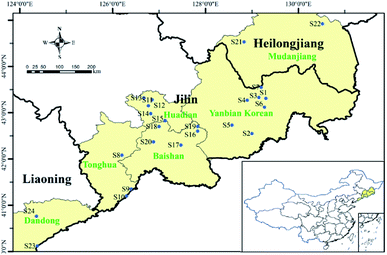 | ||
| Fig. 3 The geographic locations of collected samples. Note: the schematic map showed the Changbai Mountain areas. | ||
2.2. Physicochemical analysis of Oviductus Ranae
In this work, physicochemical analysis of 24 batches of Oviductus Ranae samples were investigated. The expansion degree, the ethanol extract, total water, and total ash inspection were determined.Note: V is the volume change (mL) of the swollen sample, W is the sample mass (g); S is the swelling capacity (mL g−1).
Note: m1: weight of extract and evaporating dish, m2: evaporating dish weight m3 weight of test product, V: volume.
2.3. High-performance liquid chromatography analysis of steroids
![[thin space (1/6-em)]](https://www.rsc.org/images/entities/char_2009.gif) :
:![[thin space (1/6-em)]](https://www.rsc.org/images/entities/char_2009.gif) 13 as mobile phase. The column temperature was maintained at 35 °C and the injection volume was 10 μL. Quantification was carried out by the integration of each peak using the external standard method.
13 as mobile phase. The column temperature was maintained at 35 °C and the injection volume was 10 μL. Quantification was carried out by the integration of each peak using the external standard method.2.4. Statistical analysis
Note: εki is the calculation result for optimum reference sequence and worst reference sequence. γi is the result of relative correlation degree.
3. Results and discussion
3.1. Physicochemical analysis
Physicochemical analysis of Oviductus Ranae included expansion degree analysis, ethanol extract analysis, total water analysis, and total ash analysis.10 Those analyses can be used to assess the qualities of Oviductus Ranae.35,36 The results showed that the expansion degrees of 24 batches of Oviductus Ranae were between 57 and 100 mL g−1. All samples collected met the expansion requirements of the Chinese Pharmacopoeia. The highest content of ethanol extract was 6.4% and the lowest content was 2.7%. Most of the ethanol extracts content were from 4.0% to 5.5%. There was no significant difference in the total water contents of the Oviductus Ranae samples in the main producing areas. The water contents in most areas were 10.0%–13.0%. The total ash contents were between 3.0% and 5.0% which were changed slightly. The results of physicochemical analysis are shown in Table 2.| No. | Expansion degree (mL g−1) | Ethanol extract (%) | Total water (%) | Total ash (%) |
|---|---|---|---|---|
| S1 | 98.7 | 5.72 | 11.37 | 4.87 |
| S2 | 61.3 | 4.45 | 10.25 | 3.99 |
| S3 | 59.3 | 4.12 | 12.50 | 4.05 |
| S4 | 67.0 | 4.18 | 14.74 | 3.66 |
| S5 | 61.7 | 6.09 | 11.07 | 2.58 |
| S6 | 76.0 | 4.21 | 13.65 | 4.76 |
| S7 | 56.2 | 4.36 | 11.49 | 4.94 |
| S8 | 91.3 | 5.18 | 10.96 | 4.15 |
| S9 | 69.3 | 6.40 | 11.46 | 4.04 |
| S10 | 57.0 | 4.37 | 12.80 | 3.80 |
| S11 | 58.0 | 2.70 | 10.75 | 3.70 |
| S12 | 93.2 | 5.33 | 17.96 | 4.70 |
| S13 | 59.7 | 4.41 | 10.77 | 3.24 |
| S14 | 57.7 | 4.55 | 12.09 | 4.81 |
| S15 | 62.7 | 3.60 | 10.30 | 4.12 |
| S16 | 62.3 | 3.82 | 13.56 | 3.01 |
| S17 | 78.8 | 3.77 | 11.86 | 3.81 |
| S18 | 73.8 | 5.59 | 7.84 | 3.69 |
| S19 | 59.3 | 4.25 | 10.82 | 3.99 |
| S20 | 79.0 | 4.30 | 11.28 | 5.35 |
| S21 | 73.3 | 4.38 | 17.53 | 4.39 |
| S22 | 72.7 | 3.14 | 10.52 | 4.30 |
| S23 | 58.0 | 3.75 | 9.33 | 3.96 |
| S24 | 60.0 | 3.42 | 8.91 | 4.07 |
3.2. The contents analysis of steroidal components of Oviductus Ranae
Oviductus Ranae contains a variety of steroidal components, which have favourable effects in nourishment and anti-fatigue.4 Fig. 4 shows the obvious difference in the contents of D, with the highest content 4.93 (μg g−1) in Dandong and the lowest 0.082 (μg g−1) in Yanbian. The highest content is 60 times more than the lowest one. The ratios of the highest content to the lowest content for other quality features A, B, C and E, swelling, ethanol extract, total ash, and total water were 1![[thin space (1/6-em)]](https://www.rsc.org/images/entities/char_2009.gif) :
:![[thin space (1/6-em)]](https://www.rsc.org/images/entities/char_2009.gif) 2.4, 1
2.4, 1![[thin space (1/6-em)]](https://www.rsc.org/images/entities/char_2009.gif) :
:![[thin space (1/6-em)]](https://www.rsc.org/images/entities/char_2009.gif) 15, 1
15, 1![[thin space (1/6-em)]](https://www.rsc.org/images/entities/char_2009.gif) :
:![[thin space (1/6-em)]](https://www.rsc.org/images/entities/char_2009.gif) 5, 1
5, 1![[thin space (1/6-em)]](https://www.rsc.org/images/entities/char_2009.gif) :
:![[thin space (1/6-em)]](https://www.rsc.org/images/entities/char_2009.gif) 19, 1
19, 1![[thin space (1/6-em)]](https://www.rsc.org/images/entities/char_2009.gif) :
:![[thin space (1/6-em)]](https://www.rsc.org/images/entities/char_2009.gif) 1.7, 1
1.7, 1![[thin space (1/6-em)]](https://www.rsc.org/images/entities/char_2009.gif) :
:![[thin space (1/6-em)]](https://www.rsc.org/images/entities/char_2009.gif) 2.4, 1
2.4, 1![[thin space (1/6-em)]](https://www.rsc.org/images/entities/char_2009.gif) :
:![[thin space (1/6-em)]](https://www.rsc.org/images/entities/char_2009.gif) 2, 1
2, 1![[thin space (1/6-em)]](https://www.rsc.org/images/entities/char_2009.gif) :
:![[thin space (1/6-em)]](https://www.rsc.org/images/entities/char_2009.gif) 2.3. The above results showed the difference of the contents of Oviductus Ranae in Changbai Mountains. Those differences might be due to the various of environmental factors. The relationship between the quality of the Oviductus Ranae and the place of origin Oviductus Ranae was not obvious through visual analysis. Therefore, chemometrics was used to investigate the corresponding relations.
2.3. The above results showed the difference of the contents of Oviductus Ranae in Changbai Mountains. Those differences might be due to the various of environmental factors. The relationship between the quality of the Oviductus Ranae and the place of origin Oviductus Ranae was not obvious through visual analysis. Therefore, chemometrics was used to investigate the corresponding relations.
The contents of quality features in different producing areas in Changbai Mountains were compared. The contents of A, B and E in Huadian were higher than that in other areas, but the content of C, an ingredient that causes atherosclerosis easily,37,38 was lower than the others (Fig. 5a–c and e). D in Dandong and Huadian samples was higher than that in other areas (Fig. 5d). The content of ethanol extract in Tonghua area was slightly higher than that in other regions (Fig. 5g). C was slightly high in Mudanjiang areas (Fig. 5c). The regional differences in swelling, total water, and total ash were not obvious (Fig. 5h and i). The steroid contents of Oviductus Ranae in Huadian area were slightly higher than the others.
3.3. Gray correlation analysis (GCA)
GCA is a dynamically developing system based on the similarity or dissimilarity of the development trends among factors using the numerical relationship of each factor.39 The method is simple, accurate, and reliable which can be used for quantitative analysis. GCA can overcome the shortcomings and limitations of correlation regression analysis and is therefore widely used to investigate the influences of environmental factors on food quality and safety.40–43 The GCA results could be used to deduce the main environmental factors. The main environmental factors could be determined using the components of steroids as the primary factors and environmental factors as the sub-factors. Adjusting different environmental factors, the accumulation of steroidal ingredients may be impacted. The effect of environmental factors on the steroidal ingredients by gray correlation analysis was shown in the Table 3. If the relative correlation value is high, the influence is strong. Latitude had an obvious effect on A and E. Altitude had an obvious effect on B and C. The annual average temperature had a markable correlation with D.| A | B | C | D | E | |
|---|---|---|---|---|---|
| a A cholesterol, B 7-hydroxycholesterol, C 7-keto-cholesterol, D cholest-4-en-3-one and E 7-dehydrocholesterol. | |||||
| Altitude (m) | 0.6637 | 0.7737 | 0.7417 | 0.7537 | 0.6637 |
| Annual average temperature (°C) | 0.7114 | 0.7137 | 0.6627 | 0.7998 | 0.7163 |
| Annual precipitation (mm) | 0.5711 | 0.6088 | 0.5566 | 0.7685 | 0.6581 |
| Longitude | 0.7613 | 0.6834 | 0.6406 | 0.7843 | 0.7272 |
| Latitude | 0.7644 | 0.6852 | 0.6438 | 0.7848 | 0.7305 |
It can be seen from the Table 4 that the relative correlations between the 24 samples of the Changbai Mountains were 0.395–0.605, indicating that there was a significant difference in the quality of Oviductus Ranae from different producing areas. 10 Samples showed relative correlation greater than 0.5. The quality of these samples was higher than the others, which were mainly produced in Huadian area. Among them, the S14, S15, and S12 regions had the highest relative correlation which in the top three. The result is consistent with the evaluation of the Oviductus Ranae market. This work was more systematic and objective than a single component evaluation. It can also comprehensively reflect the quality of Oviductus Ranae in Changbai Mountains. At the same time, it provides clues for the selection of suitable habitats of Rana chensinensis.
| No. | Relative relevance | Rank | No. | Relative relevance | Rank |
|---|---|---|---|---|---|
| a According to the result of gray correlation coefficients, we could conclude that the quality sequencing of the samples was S14 > S15 > S12 > S1 > S17 > S8 > S18 > S10 > S13 > S3 > S11 > S21 > S23 > S2 > S6 = S4 > S20 > S5 > S7 > S9 > S29. | |||||
| S1 | 0.529 | 4 | S13 | 0.507 | 9 |
| S2 | 0.476 | 14 | S14 | 0.605 | 1 |
| S3 | 0.503 | 10 | S15 | 0.558 | 2 |
| S4 | 0.473 | 15 | S16 | 0.465 | 18 |
| S5 | 0.440 | 21 | S17 | 0.528 | 5 |
| S6 | 0.473 | 15 | S18 | 0.513 | 7 |
| S7 | 0.436 | 22 | S19 | 0.395 | 24 |
| S8 | 0.521 | 6 | S20 | 0.468 | 17 |
| S9 | 0.430 | 23 | S21 | 0.495 | 12 |
| S10 | 0.509 | 8 | S22 | 0.445 | 20 |
| S11 | 0.498 | 11 | S23 | 0.487 | 13 |
| S12 | 0.541 | 3 | S24 | 0.464 | 19 |
3.4. Multiple linear regression (MLR)
MLR is a mathematical tool that quantifies the relationship between a dependent variable and one or more independent variables.44 The correlation coefficient between steroidal components and various environmental factors is shown in Table 5. According to the results of multiple linear regression analysis, there was a certain correlation between different quality features of Oviductus Ranae and the environmental factors. Among components assessed in this work, altitude was positively correlated with B (p < 0.05) and expansion degree (p < 0.01) respectively (Fig. 6a and c). The Annual average temperature showed a remarkable positive correlation with the contents of D (p < 0.01) (Fig. 6b). Annual precipitation was negatively correlated with total water (p < 0.05) (Fig. 6d). The results were consistent with the results of the gray correlation analysis. The other environmental factors had little influence on the quality features.| Altitude | Annual average temperature°C | Annual precipitation (mm) | Longitude | Latitude | |
|---|---|---|---|---|---|
| a Values are Pearson correlation coefficients. *p < 0.05, **p < 0.01, values without asterisks are not significant at P < 0.05. A cholesterol, B 7-hydroxycholesterol, C 7-keto-cholesterol, D cholest-4-en-3-one and E 7-dehydrocholesterol. | |||||
| A | −0.113 | 0.071 | −0.132 | 0.117 | 0.230 |
| B | 0.460* | −0.224 | 0.009 | 0.030 | 0.300 |
| C | 0.212 | −0.169 | −0.092 | 0.089 | 0.123 |
| D | −0.094 | 0.817** | 0.416 | −0.683 | −0.539 |
| E | −0.157 | 0.122 | −0.104 | −0.077 | −0.073 |
| Expansion degree | 0.643** | −0.026 | −0.142 | 0.152 | 0.205 |
| Ethanol extract | 0.390 | −0.155 | 0.035 | 0.038 | −0.085 |
| Total water | −0.001 | −0.181 | −0.436* | 0.302 | 0.411 |
| Total ash | 0.151 | 0.325 | −0.224 | 0.114 | 0.172 |
3.5. Analysis the of steroidal components and environmental factors
The samples collected were from the main producing area with altitude 200–1000 m. The contents of steroidal components other than D were relatively higher in 300–400 m altitude. At the range of about 620 m to 650 m altitude, the contents of steroidal components showed a zigzag line (Fig. S1†), which may because of the influence of the enrichment ability on this species under different pressures. In addition, the altitude ranges from 700 to 1000 m, the other four substances have an increasing tendency except for E (Fig. S1†). The annual precipitations in the Changbai Mountains were between 700 and 1400 mm. It was from June to September accounts for 60–70% of the annual precipitation. The annual average rainfall has a relatively stable effect on the enrichment ability of components except for A (Fig. S2†).The Changbai Mountains belong to the temperate continental mountain climate which is affected by the monsoon. In addition to the characteristics of the general mountain climate, there are also obvious vertical climate changes. The annual sunshine hours are less than 2300 hours, and the annual average temperature is low. D enrichment ability has positive correlation with the annual average temperature. When the average temperature was less than 3.2 degrees Celsius, E and D were not affected by temperature. The other substances showed high concentrations. It may be due to the low temperature affected the enrichment ability of A by Rana chensinensis. B and C are converted from A. When the annual average temperature is higher than 6 degrees Celsius, steroidal components showed a decreasing trend except for D (Fig. S3†).
4. Conclusions
This work studies the influence that environmental factors (including altitude, annual average temperature, annual precipitation, latitude and longitude) on each quality indicator of Oviductus Ranae. The indicators contain expansion degree, ethanol extract, total water, total ash and steroids. Through gray correlation and multivariate linear analysis, the quality of Oviductus Ranae is closely related to altitude, annual average temperature and annual precipitation. Altitude has a positive correlation with the content of 7-hydroxycholesterol (B) and expansion degree, with altitude having a significant correlation on expansion degree. The annual average temperature has a significant positive correlation with the content of cholest-4-en-3-one (D), and annual precipitation has a negative correlation with total water. There is no correlation between the latitude and longitude, and it has little effect on the quality of Oviductus Ranae. The factors that comprehensively assess the quality of Oviductus Ranae are altitude > annual average temperature > annual precipitation ≫ latitude and longitude. In conclusion, this work firstly proposed that environmental factors have influence on the quality features of Oviductus Ranae. It provides a reference for the quality analysis of Oviductus Ranae and breeding of Rana temporaria chensinensis.Conflicts of interest
There are no conflicts to declare.Acknowledgements
This research was supported by Jilin Bureau of Quality and Technical Supervision, grant number DBXM085-2018 and Administration of Traditional Chinese Medicine of Jilin Province, grant number 2019153.Notes and references
- Y. Zhang, Y. Wang, M. Li, S. Liu, J. Yu, Z. Yan and H. Zhou, Oxid. Med. Cell. Longevity, 2019, 2019, 24 Search PubMed.
- A. Santini and E. Novellino, Foods, 2017, 6, 74 CrossRef.
- H. Di, Y. Lubing, W. Chenlu, M. Sihui, C. Li, H. Shiyang, S. Xia, W. Qiang and X. Meiyu, J. Evidence-Based Complementary Altern. Med., 2014, 2014, 180234 Search PubMed.
- Y. Xu, S. Wang, Y. Luo, Y. Wang and X. Qu, J. Liq. Chromatogr. Relat. Technol., 2015, 38, 1218–1222 CrossRef CAS.
- Y. Wang, H. Chi, Y. Xu, Y. Luo and X. Qu, J. Changchun Univ. Tradit. Chin. Med., 2014, 30, 604–606 Search PubMed.
- Q. Xu, C. Dou, X. Liu, L. Yang, C. Ni, J. Wang, Y. Guo, W. Yang, X. Tong and D. Huang, Biomed. Pharmacother., 2018, 107, 1692–1704 CrossRef CAS.
- H. Bao, Y. Xu, y. Wang and S. Wang, Special Wild Econ. Anim. Plant Res., 2019, 02, 85–88 Search PubMed.
- Y. Wang, L. Wang, Y. Hu, L. Zhang and Z. Wang, Nat. Prod. Res., 2010, 24, 1518–1522 CrossRef CAS.
- Y. Zhang, K. Zhu, H. Cui, Y. Liu, Y.-F. Lu, H.-W. Pan, H.-P. Zhao, L. Qi, X.-D. Yang and H.-L. Zhou, J. Ethnopharmacol., 2017, 203, 101–109 CrossRef.
- D. Jiang and J. Xiao, J. Chin. Med. Mater., 2007, 30, 429–432 Search PubMed.
- L. Zhang, Master thesis, Changchun University of Chinese Medicne, 2011.
- L. Xingyue, N. Zhang, L. Weng, Z. Qiu and Q. Zhang, J. Changchun Univ. Tradit. Chin. Med., 2017, 33, 541–543 Search PubMed.
- S. Wang, Y. Xu, Y. Wang, H. Yang, Z. Lv, X. Jin and Y. Wang, J. Anal. Methods Chem., 2017, 2017, 9194847 Search PubMed.
- Y. Liu and L. Liu, Strait Pharm. J., 2007, 19, 1–3 Search PubMed.
- A. Abuhammad, Br. J. Pharmacol., 2017, 174, 2194–2208 CrossRef CAS.
- H. Albuquerque, C. Santos and A. Silva, Molecules, 2018, 24, 116 CrossRef.
- W. Andrew, H. Shihyieh, X. Li, A. Joseph and S. Richard, Neurosurgery, 1998, 42, 592–598 CrossRef.
- X. Cao, S. Sun, Y. Yao and W. Zang, Chin. J. Clin. Rehabil., 2005, 20, 333–336 Search PubMed.
- C.-W. Wang, C.-C. Huang, P.-H. Chou, Yu-P. Chang, S. Wei, F. P. Guengerich, Y.-C. Chou, S.-F. Wang, P.-S. Lai, P. Souček and Y.-F. Ueng, OncoTargets Ther., 2017, 8, 66033–66050 Search PubMed.
- Q. Zhang, Z. Wu, J. Cao, H. Xue, R. Feng and Z. Du, Mil. Med. Sci., 1996, 20, 27–29 Search PubMed.
- S. Kunio, S. Takeshi and N. Tadashi, Bioorg. Med. Chem. Lett., 1998, 8, 2133–2138 CrossRef.
- A. Jusakul, W. Loilome, N. Namwat, W. Haigh, R. Kuver, S. Dechakhamphu, P. Sukontawarin, S. Pinlaor, S. Lee and P. Yongvanit, Mutat. Res., Fundam. Mol. Mech. Mutagen., 2012, 731, 48–57 CrossRef CAS.
- C. Lv, Y. Chen, L. Wang, S. Yang and W. Wang, J. Food Sci. Biotechnol., 2001, 20, 485–488 Search PubMed.
- C. Castronovo, V. Castronovo, A. Nikkels and O. Peulen, Rev. Med. Liege, 2015, 70, 495–500 CAS.
- H. Yan, Z. Fang, J. Fu and S. Yu, Am. J. Chin. Med., 2010, 38, 473–483 CrossRef CAS.
- C. Zhang, D. Yang, Z. Liang, J. Liu, K. Yan, Y. Zhu and S. Yang, Sci. Rep., 2019, 9, 904 CrossRef.
- W. Liu, J. Liu, D. Yin and X. Zhao, PLoS One, 2015, 10, e0122981 CrossRef.
- M. R. Marami Milani, A. Hense, E. Rahmani and A. Ploeger, Foods, 2016, 5, 52 CrossRef.
- Y. Wang, R. Chen and X. Zhang, Lishizhen Med. Mater. Med. Res., 2008, 19, 2920–2922 CAS.
- Y. Gan, Y. Xiao, S. Wang, H. Guo, M. Liu, Z. Wang and Y. Wang, Molecules, 2019, 24, 1687 CrossRef PubMed.
- Y. Zhang, Y. Liu, K. Zhu, Y. Dong, H. Cui, L. Mao, X. Xu and H. Zhou, Oxid. Med. Cell. Longevity, 2018, 9021371 Search PubMed.
- R. Liu, PhD thesis, Jilin agricultural University, 2016.
- Q. Liang, PhD thesis, Jilin University, 2012.
- S. Wang, Y. Hua, L. Xu, L. Zou, X. Liu, Y. Luo, J. Liu and Y. Yan, Molecules, 2016, 21, E850 CrossRef PubMed.
- Y. Fan, J. Lu, C. Wang, Y. Song and J. Liu, Cent. South Pharm., 2014, 12, 175–177 Search PubMed.
- D. Jiang and J. Xiao, J. Chin. Med. Mater., 2007, 10, 1212–1214 Search PubMed.
- C. He, H. Zhu, W. Zhang, I. Okon, Q. Wang, H. Li, Y.-Z. Le and Z. Xie, Am. J. Pathol., 2013, 183, 626–637 CrossRef CAS.
- T. Mariko, K. Yuko, D. Michiyo, O. Mizuko and Y. Masayuki, PLoS One, 2018, 13, e0200499 CrossRef PubMed.
- J. Dong, X. Ma, Q. Wei, S. Peng and S. Zhang, Ind. Crops Prod., 2011, 34, 1607–1614 CrossRef CAS.
- C. Chen, Z. Liu, L. Zou, X. Liu, C. Chai, H. Zhao, Y. Yan and C. Wang, Molecules, 2018, 23, E573 CrossRef.
- X. Lin, S. Cui, Y. Han, Z. Geng and Y. Zhong, Food Control, 2019, 99, 48–56 CrossRef.
- S. Zou, Y. Chen, W. Xu, S. He and B. Wang, Chin. J. Exp. Tradit. Med. Formulae, 2016, 22, 30–35 Search PubMed.
- T. Zhu, L. Wu, X. Wang, H. Zhu, X. Zhu, Q. Zhou, X. Liu and B. Cai, J. Funct. Foods, 2017, 31, 104–112 CrossRef CAS.
- Y. Zhang, H. Ma, B. Wang, W. Qu, A. Wali and C. Zhou, J. Sci. Food Agric., 2016, 96, 3313–3320 CrossRef CAS.
Footnote |
| † Electronic supplementary information (ESI) available. See DOI: 10.1039/c9ra04823e |
| This journal is © The Royal Society of Chemistry 2019 |

